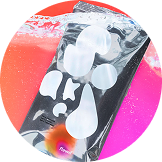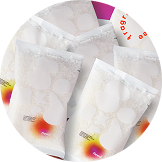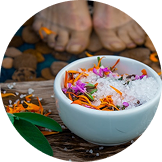Living with Hashimoto's disease is a daily battle against fatigue, brain fog, and a body that seems to work against you at every turn.
While traditional treatments like hormone replacement therapy (HRT) have their place, what if you could manage the symptoms of this condition more naturally? That’s what we’re here to discuss today in this guide on magnesium and Hashimoto’s.
This mineral has helped countless individuals regain control of their lives by improving energy levels, easing muscle and joint pain, supporting thyroid hormone conversion, and balancing immune function.
The only catch is you need to use the best magnesium for Hashimoto’s - easier said than done with all the different types and supplements at your fingertips. The good news is your search ends here at Flewd Stresscare, where you’ll discover the best magnesium soak for rapid relief.
So, learn all about Hashimotos and magnesium below - or take the next step towards living life on your own terms once again by trying our magnesium bath soak!
Overview of Hashimoto’s and Magnesium
Also known as Hashimoto's thyroiditis, this autoimmune disorder causes the immune system to attack the thyroid gland. If you don’t know much about the thyroid, all you need to know is it’s essential for overall bodily function.
It’s a small, butterfly-shaped gland at the base of the neck responsible for producing hormones that regulate metabolism and energy levels. But when it’s inflamed and impaired, it can lead to hypothyroidism - a condition where the thyroid doesn’t produce enough hormones.
Common Symptoms of Hashimoto’s
What makes Hashimoto’s disease so brutal is how far-reaching the symptoms can be. This condition can manifest itself in persistent fatigue, weight gain, hair thinning, sensitivity to cold, and cognitive difficulties such as brain fog.
In this sense, it makes even routine tasks like running errands or getting work done feel impossible. It can take a toll on your confidence by impacting your appearance, too.
In the long run, unmanaged Hashimoto's can spiral into more serious problems. That’s why coming up with strategies for managing this condition is so important. So, how does magnesium fit into the conversation?
What Does Magnesium Do in the Body?
This mineral influences over 300 biochemical reactions in the body. We have a guide discussing all the benefits of magnesium soak - from magnesium muscle recovery to magnesium for stress relief.
Magnesium plays a role in muscle and nerve function, helps maintain steady heart rhythms, and supports bone health. It’s also essential for energy production since it helps activate ATP - the energy currency of cells in the body. It even regulates neurotransmitters, impacting mood.
Beyond these basic functions, magnesium helps maintain healthy blood pressure, supports the immune system, and contributes to better sleep quality by calming the nervous system.
There are so many other conditions beyond Hashimoto’s that draw individuals towards magnesium. We’ve written similar resources on magnesium for menstrual cramps and magnesium and endometriosis.
But what are the signs your body is actually lacking in magnesium?
Signs of Magnesium Deficiency
Unfortunately, the vast majority of people are chronically deficient in magnesium. That’s because its symptoms are subtle, at least at first. It doesn’t help that magnesium is poorly absorbed orally through food and supplements, either. Here are some of the signs of deficiency:
- Muscle cramps, spasms, or twitches
- Persistent fatigue or lack of energy
- Irritability or mood swings
- Difficulty sleeping or frequent waking
- Headaches or migraines
- Irregular heart rhythms or palpitations
Do any of these sound familiar? Chances are, you’re deficient in magnesium. While any otherwise healthy individual could benefit from upping their magnesium intake, it’s especially important for those battling Hashimoto's disease. Here’s why…
Why Try Using Magnesium for Hashimoto’s?
Is it worth trying magnesium for Hashimoto’s? We believe so - and it’s not hard to see why. There are quite a few symptoms of this condition that can be improved simply by taking more magnesium. Let’s take a look.
Reducing Inflammation
At its core, Hashimoto’s is an autoimmune condition characterized by chronic inflammation in the thyroid gland. Magnesium brings anti-inflammatory properties to help regulate immune responses and reduce inflammatory markers in the body.
This mechanism can ease the flare-ups of other symptoms such as fatigue, joint pain, and swelling, as we’ll elaborate on below. But perhaps the most powerful connection between Hashimoto’s and magnesium is in how it supports the thyroid directly.
Supporting Thyroid Hormone Production
We said earlier magnesium plays hundreds of roles in the body, and one of those happens to be regulating thyroid hormone production. The mineral influences the conversion of T4 (inactive thyroid hormone) to T3 (active thyroid hormone).
Why does this matter? Simple - T3 is the hormone your body actually uses for energy and metabolic processes. T4 in its raw form does nothing for you. Unfortunately, those suffering from Hashimoto’s struggle with this conversion process, so getting more magnesium is important.
Alleviating Muscle Cramps and Fatigue
If you’re currently living with this condition you know all too well the toll that muscle pain and persistent fatigue can take.
Fortunately, magnesium helps relax muscles and supports energy production at the cellular level. It replenishes magnesium stores so you feel less discomfort and more sustained energy throughout the day.
Balancing Stress and Sleep Patterns
It’s well known that stress makes the symptoms of autoimmune conditions worse. Unfortunately, the mere diagnosis of Hashiomoto’s can be a source of stress, and the way in which it impairs your ability to do simple things can cause stress of its own.
This leads to a vicious cycle since stress depletes magnesium, and magnesium is essential for supporting a healthier stress response. That’s why it’s imperative you consume more magnesium.
This mineral regulates cortisol (the infamous stress hormone) to promote relaxation. It also boosts GABA production, a neurotransmitter that calms the nervous system.
Magnesium even improves sleep quality by promoting deeper, more restful sleep. It helps you wake up feeling refreshed and free from the constant fatigue and exhaustion Hashimoto’s is characterized by.
Other Reasons to Try Magnesium for Hashimotos
There are plenty more connections between magnesium and Hashimoto’s. For instance, those who have been diagnosed struggle with nutrient deficiencies due to impaired gut function - but magnesium can help bolster the absorption of key nutrients like calcium and vitamin D.
It can also help alleviate digestive issues including constipation, another common symptom of Hashimoto’s. Magnesium is a natural muscle relaxant that supports healthier bowel movements.
While it’s not a standalone treatment or a miracle mineral, it’s an easy addition to a more comprehensive Hashimoto’s management regimen. There’s just one caveat - you need to use the BEST magnesium for Hashimoto’s to reap all the benefits it has to offer.
What is the Best Magnesium for Hashimoto’s?
There are quite a few different forms of magnesium at your disposal, with the most popular being magnesium oxide or magnesium sulfate (known more commonly as epsom salt).
As you’ll see below, though, these are not going to move the needle for you as far as relief from Hashimoto’s symptoms go. There are also dramatic differences between topical magnesium vs oral supplements. Here’s what you need to know about the best magnesium for Hashimoto’s.
Understanding Different Types of Magnesium
It’s easy to get overwhelmed by the sheer number of magnesium types on the market. Each has its pros and cons, but long story short, magnesium chloride is your best bet for Hashimoto’s - or any condition for that matter.
But what’s the problem with other forms of magnesium, such as magnesium sulfate or magnesium citrate? Let’s take a closer look at each:
- Magnesium Glycinate: Its calming effects mean it’s great for managing stress and promoting relaxation. However, it lacks the powerful anti-inflammatory and skin-friendly properties of other forms, like magnesium chloride.
- Magnesium Malate: Often used for muscle pain and fatigue. This type also supports energy production but is less effective at replenishing magnesium levels transdermally. We’ll explain why that’s a problem in just a few moments.
- Magnesium Sulfate (Epsom Salt): Perhaps the most common choice for healing bath recipes because it’s so readily available. It offers temporary muscle soreness relief but doesn’t absorb as effectively or provide the long-lasting benefits of magnesium chloride.
- Magnesium Citrate: Useful for addressing constipation, but its strong laxative effect can be a double-edged sword. It’s not suitable for daily use for this reason.
Meanwhile, magnesium chloride is recognized as the gold standard for Hashimoto’s. The primary reason is it has the highest bioavailability of all types of magnesium - which basically means your body is able to actually put it to use.
In contrast, many of the other forms have low bioavailability, which means only a small percentage of what you take is utilized and the rest is excreted as waste.
Magnesium chloride not only replenishes depleted stores but also directly supports thyroid function and reduces systemic inflammation. It’s undoubtedly the best magnesium for Hashimoto’s, but only when taken transdermally. Here’s why…
Oral vs Topical Magnesium Supplements
When most people think of supplementing magnesium they envision pills or powders. These supplements are cheap and easy to get your hands on, but the harsh truth is they typically cause more harm than good.
This goes back to bioavailability. Magnesium is poorly absorbed through the digestive system, which means most of what you take is not going to be put to use.
One possible solution is to take more magnesium to compensate, but this is going to produce really uncomfortable side effects such as diarrhea. The good news? You can avoid these symptoms altogether and maximize uptake with a topical magnesium supplement.
Wait, does magnesium soak into skin? Why is magnesium soak good for you? We believe this is the best way to tap into the connection between Hashimoto’s and magnesium.
The skin only absorbs what it needs to replenish magnesium stores so you never have to worry about toxicity. You are bypassing the digestive system altogether this way, too, so you won’t experience any uncomfortable side effects.
Soaking in a magnesium-rich bath distributes the mineral evenly throughout your entire body. Plus, this approach offers maximum bioavailability. While other topical solutions like lotions and sprays have their place, we believe the #1 choice is only a few clicks away at Flewd Stresscare.
What Makes Our Magnesium Bath Soaks So Effective for Hashimoto’s?
We’ve developed a line of magnesium bath soaks that deliver the highest-quality magnesium chloride alongside other targeted ingredients to combat the symptoms of Hashimoto’s. Whether you’re looking for a muscle bath soak or stress relief bath soak, we’ve got you covered.
Every soak is free of toxins, artificial fragrances, and unnecessary additives. They’re vegan and cruelty-free, biodegradable, and sure to make a difference in the way you feel - for up to 5 days in each soak!
So what is a bath soak made of beyond the most bioavailable magnesium chloride? We’ve included carefully curated botanicals, vitamins, nootropics, and minerals. Here’s a look at what’s inside each formulation:
- Sads Smashing Soak: Features B vitamins, and nootropic lithium to stabilize mood, reduce stress, and improve overall mental clarity. Its bright, refreshing scent makes it a joy to use.
- Insomnia Ending Soak: The perfect way to wind down and drift away to dreamland with L-carnitine, vitamins A and E, and calming botanicals.
- Panic Crushing Soak: Boron and omega-3s work in synergy with magnesium to reduce hormonal fluctuations and calm both the body and mind, helping you find your inner zen.
- Rage Squashing Soak: Magnesium, chromium, and B12 target irritability and restore emotional balance. You’ll love the clean, invigorating aroma as well.
- Ache Erasing Soak: This powerhouse blend of magnesium chloride, vitamin C, vitamin D, and omega-3s reduces inflammation, eases muscle pain, and supports recovery.
Each of these has its place, and the best way to find your favorite soak is to try them all with one of our bundles. You don’t have to worry about how to use bath soak, either. It’s easy. We’ll share tips below.
Tips on Using Magnesium for Hashimoto’s
We won’t talk about how much magnesium to take orally as that’s not the approach we recommend. Instead, we want to walk you through making the most of every bath soak. Here’s a quick start guide:
- Dump an entire magnesium soak into a warm bath (remember that you’re not trying to boil yourself alive).
- Soak for at least 20 minutes to allow optimal absorption.
- Set the mood for with dim lighting or soft music to amplify relaxation.
If a bath isn’t an option, try a foot soak with half a packet of magnesium soak dissolved in warm water. This won’t have the same effect as a full body soak, but it’s better than nothing!
Frequency and consistency matter when it comes to magnesium and Hashimoto’s. We recommend using our soaks 2-3 times a week, but you can technically use them daily. This may be a good idea at first to replenish your body’s stores if you’re deficient in magnesium.
It doesn’t necessarily matter when you do your soak, but evening tends to be best since they’re very relaxing. This is the perfect way to wind down after a long, hectic day and set the stage for a night of restful sleep.
Our blog has more tips on how long to soak in a magnesium bath, how much bath soak to use, or how to make a magnesium bath soak if you’re interested. But before we wrap up our Hashimoto’s and magnesium guide we want to talk a bit more about treatment in general.
Additional Advice on Managing Hashimoto’s
We encourage you to work with your healthcare provider to come up with a comprehensive strategy for managing Hashimotos. Magnesium is just one piece of the puzzle, after all. A good starting point, though, is diet.
Dietary Adjustments
A thyroid-supportive diet features leafy greens, lean proteins, and whole grains. Eat plenty of selenium-rich foods (like Brazil nuts or eggs) to support thyroid hormone metabolism.
What you don’t eat is perhaps more important, though. Steer clear of potential inflammatory triggers like gluten and processed foods, especially if sensitivities exist. Sugar should be kept in moderation as well.
Whether you have Hashimoto’s or not make sure you’re drinking enough water on a daily basis. This is even more important with the condition as it helps flush toxins that can exacerbate inflammation.
The most important vitamins and minerals (besides magnesium) for Hashimoto’s are vitamin D, iron, and B vitamins. Get these through diet or supplements if you’re deficient.
Stress Management
It’s also worth coming up with healthy coping mechanisms for stress. After all, Hashimoto’s symptoms can be made worse by chronic stress.
Again, magnesium is a great step in the right direction, but it should be complemented with techniques like yoga, meditation, or deep breathing exercises.
Other Lifestyle Adjustments
If possible try to get regular low-impact exercise such as walking, swimming, or light strength training to boost energy without overburdening the body. Strenuous workouts can sometimes cause more harm than good, making fatigue worse.
Restorative sleep is another non-negotiable for managing Hashimoto’s, so aim for 7-9 hours nightly and establish a consistent bedtime routine. If you have trouble sleeping remember that our Insomnia Ending soak can help!
Living with Hashimoto’s can feel isolating, but connecting with others through support groups or online communities can provide encouragement and practical advice. You’re not in this battle alone!
Professional Treatments
If the advice we’ve shared so far today isn’t making a difference in your symptom burden within a few weeks or months, it may be time to visit your healthcare provider and discuss professional treatments. This will likely involve HRT.
Levothyroxine is the most common treatment. It’s a synthetic form of the thyroid hormone T4 so it can help restore normal hormone levels, alleviating symptoms like fatigue, weight gain, and brain fog. Your doctor will likely want you to get regular blood tests to track your progress.
Not sure where to start? Get in touch with an endocrinologist near you, as this specialist can provide tailored advice on managing Hashimoto’s, monitor progression, and address complications such as goiter or other autoimmune conditions.
But hopefully, relief is as effortless as a few soaks a week. Take the next step at Flewd Stresscare today and stop living life on Hashimoto’s terms!
Parting Thoughts on Hashimoto’s and Magnesium
That does it for our detailed guide on Hashimoto’s and magnesium. While this autoimmune condition can take a toll, you have more control over it than you may have realized. The best magnesium for Hashimoto’s is just a few clicks away.
Learn more about epsom salt vs magnesium flakes, disadvantages of bath bombs, is a hot bath good for sore muscles, hot bath for anxiety, can stress cause sore muscles, bath soak vs bath bomb, and more in our blog.
But whether you’re taking a bath to relieve stress or desperate for the best bath soak for sore muscles, Flewd Stresscare is here to deliver the most effective therapeutic solutions online.
Don’t let Hashimoto’s control your days - take proactive steps to feel your best now!
























































